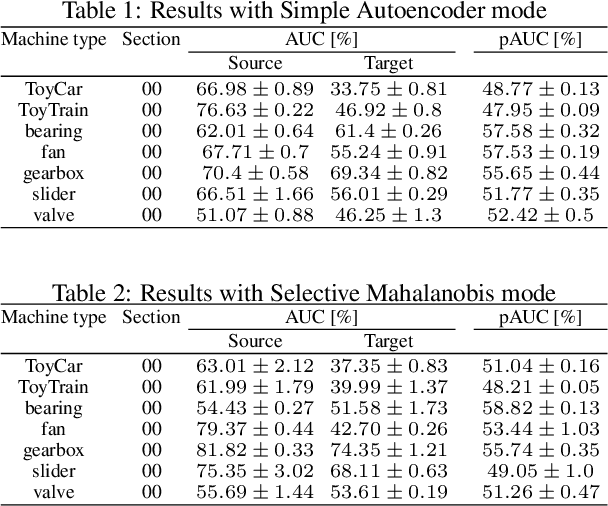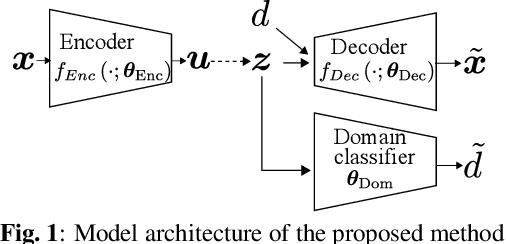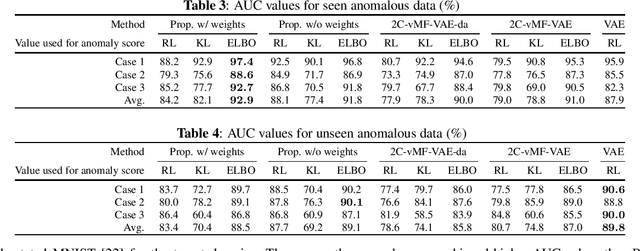Tomoya Nishida
Automatic Inspection Based on Switch Sounds of Electric Point Machines
Aug 28, 2025Abstract:Since 2018, East Japan Railway Company and Hitachi, Ltd. have been working to replace human inspections with IoT-based monitoring. The purpose is Labor-saving required for equipment inspections and provide appropriate preventive maintenance. As an alternative to visual inspection, it has been difficult to substitute electrical characteristic monitoring, and the introduction of new high-performance sensors has been costly. In 2019, we implemented cameras and microphones in an ``NS'' electric point machines to reduce downtime from equipment failures, allowing for remote monitoring of lock-piece conditions. This method for detecting turnout switching errors based on sound information was proposed, and the expected test results were obtained. The proposed method will make it possible to detect equipment failures in real time, thereby reducing the need for visual inspections. This paper presents the results of our technical studies aimed at automating the inspection of electronic point machines using sound, specifically focusing on ``switch sound'' beginning in 2019.
MIMII-Agent: Leveraging LLMs with Function Calling for Relative Evaluation of Anomalous Sound Detection
Jul 28, 2025Abstract:This paper proposes a method for generating machine-type-specific anomalies to evaluate the relative performance of unsupervised anomalous sound detection (UASD) systems across different machine types, even in the absence of real anomaly sound data. Conventional keyword-based data augmentation methods often produce unrealistic sounds due to their reliance on manually defined labels, limiting scalability as machine types and anomaly patterns diversify. Advanced audio generative models, such as MIMII-Gen, show promise but typically depend on anomalous training data, making them less effective when diverse anomalous examples are unavailable. To address these limitations, we propose a novel synthesis approach leveraging large language models (LLMs) to interpret textual descriptions of faults and automatically select audio transformation functions, converting normal machine sounds into diverse and plausible anomalous sounds. We validate this approach by evaluating a UASD system trained only on normal sounds from five machine types, using both real and synthetic anomaly data. Experimental results reveal consistent trends in relative detection difficulty across machine types between synthetic and real anomalies. This finding supports our hypothesis and highlights the effectiveness of the proposed LLM-based synthesis approach for relative evaluation of UASD systems.
Retrieving Time-Series Differences Using Natural Language Queries
Mar 27, 2025Abstract:Effectively searching time-series data is essential for system analysis; however, traditional methods often require domain expertise to define search criteria. Recent advancements have enabled natural language-based search, but these methods struggle to handle differences between time-series data. To address this limitation, we propose a natural language query-based approach for retrieving pairs of time-series data based on differences specified in the query. Specifically, we define six key characteristics of differences, construct a corresponding dataset, and develop a contrastive learning-based model to align differences between time-series data with query texts. Experimental results demonstrate that our model achieves an overall mAP score of 0.994 in retrieving time-series pairs.
Timbre Difference Capturing in Anomalous Sound Detection
Oct 29, 2024



Abstract:This paper proposes a framework of explaining anomalous machine sounds in the context of anomalous sound detection~(ASD). While ASD has been extensively explored, identifying how anomalous sounds differ from normal sounds is also beneficial for machine condition monitoring. However, existing sound difference captioning methods require anomalous sounds for training, which is impractical in typical machine condition monitoring settings where such sounds are unavailable. To solve this issue, we propose a new strategy for explaining anomalous differences that does not require anomalous sounds for training. Specifically, we introduce a framework that explains differences in predefined timbre attributes instead of using free-form text captions. Objective metrics of timbre attributes can be computed using timbral models developed through psycho-acoustical research, enabling the estimation of how and what timbre attributes have changed from normal sounds without training machine learning models. Additionally, to accurately determine timbre differences regardless of variations in normal training data, we developed a method that jointly conducts anomalous sound detection and timbre difference estimation based on a k-nearest neighbors method in an audio embedding space. Evaluation using the MIMII DG dataset demonstrated the effectiveness of the proposed method.
Retrieval-Augmented Approach for Unsupervised Anomalous Sound Detection and Captioning without Model Training
Oct 29, 2024Abstract:This paper proposes a method for unsupervised anomalous sound detection (UASD) and captioning the reason for detection. While there is a method that captions the difference between given normal and anomalous sound pairs, it is assumed to be trained and used separately from the UASD model. Therefore, the obtained caption can be irrelevant to the differences that the UASD model captured. In addition, it requires many caption labels representing differences between anomalous and normal sounds for model training. The proposed method employs a retrieval-augmented approach for captioning of anomalous sounds. Difference captioning in the embedding space output by the pre-trained CLAP (contrastive language-audio pre-training) model makes the anomalous sound detection results consistent with the captions and does not require training. Experiments based on subjective evaluation and a sample-wise analysis of the output captions demonstrate the effectiveness of the proposed method.
MIMII-Gen: Generative Modeling Approach for Simulated Evaluation of Anomalous Sound Detection System
Sep 27, 2024



Abstract:Insufficient recordings and the scarcity of anomalies present significant challenges in developing and validating robust anomaly detection systems for machine sounds. To address these limitations, we propose a novel approach for generating diverse anomalies in machine sound using a latent diffusion-based model that integrates an encoder-decoder framework. Our method utilizes the Flan-T5 model to encode captions derived from audio file metadata, enabling conditional generation through a carefully designed U-Net architecture. This approach aids our model in generating audio signals within the EnCodec latent space, ensuring high contextual relevance and quality. We objectively evaluated the quality of our generated sounds using the Fr\'echet Audio Distance (FAD) score and other metrics, demonstrating that our approach surpasses existing models in generating reliable machine audio that closely resembles actual abnormal conditions. The evaluation of the anomaly detection system using our generated data revealed a strong correlation, with the area under the curve (AUC) score differing by 4.8\% from the original, validating the effectiveness of our generated data. These results demonstrate the potential of our approach to enhance the evaluation and robustness of anomaly detection systems across varied and previously unseen conditions. Audio samples can be found at \url{https://hpworkhub.github.io/MIMII-Gen.github.io/}.
Domain-Independent Automatic Generation of Descriptive Texts for Time-Series Data
Sep 25, 2024



Abstract:Due to scarcity of time-series data annotated with descriptive texts, training a model to generate descriptive texts for time-series data is challenging. In this study, we propose a method to systematically generate domain-independent descriptive texts from time-series data. We identify two distinct approaches for creating pairs of time-series data and descriptive texts: the forward approach and the backward approach. By implementing the novel backward approach, we create the Temporal Automated Captions for Observations (TACO) dataset. Experimental results demonstrate that a contrastive learning based model trained using the TACO dataset is capable of generating descriptive texts for time-series data in novel domains.
Description and Discussion on DCASE 2024 Challenge Task 2: First-Shot Unsupervised Anomalous Sound Detection for Machine Condition Monitoring
Jun 11, 2024
Abstract:We present the task description of the Detection and Classification of Acoustic Scenes and Events (DCASE) 2024 Challenge Task 2: First-shot unsupervised anomalous sound detection (ASD) for machine condition monitoring. Continuing from last year's DCASE 2023 Challenge Task 2, we organize the task as a first-shot problem under domain generalization required settings. The main goal of the first-shot problem is to enable rapid deployment of ASD systems for new kinds of machines without the need for machine-specific hyperparameter tunings. This problem setting was realized by (1) giving only one section for each machine type and (2) having completely different machine types for the development and evaluation datasets. For the DCASE 2024 Challenge Task 2, data of completely new machine types were newly collected and provided as the evaluation dataset. In addition, attribute information such as the machine operation conditions were concealed for several machine types to mimic situations where such information are unavailable. We will add challenge results and analysis of the submissions after the challenge submission deadline.
Description and Discussion on DCASE 2023 Challenge Task 2: First-Shot Unsupervised Anomalous Sound Detection for Machine Condition Monitoring
May 13, 2023



Abstract:We present the task description of the Detection and Classification of Acoustic Scenes and Events (DCASE) 2023 Challenge Task 2: "First-shot unsupervised anomalous sound detection (ASD) for machine condition monitoring". The main goal is to enable rapid deployment of ASD systems for new kinds of machines using only a few normal samples, without the need for hyperparameter tuning. In the past ASD tasks, developed methods tuned hyperparameters for each machine type, as the development and evaluation datasets had the same machine types. However, collecting normal and anomalous data as the development dataset can be infeasible in practice. In 2023 Task 2, we focus on solving first-shot problem, which is the challenge of training a model on a few machines of a completely novel machine type. Specifically, (i) each machine type has only one section, and (ii) machine types in the development and evaluation datasets are completely different. We will add challenge results and analysis of the submissions after the challenge submission deadline.
Zero-shot domain adaptation of anomalous samples for semi-supervised anomaly detection
Apr 05, 2023



Abstract:Semi-supervised anomaly detection~(SSAD) is a task where normal data and a limited number of anomalous data are available for training. In practical situations, SSAD methods suffer adapting to domain shifts, since anomalous data are unlikely to be available for the target domain in the training phase. To solve this problem, we propose a domain adaptation method for SSAD where no anomalous data are available for the target domain. First, we introduce a domain-adversarial network to a variational auto-encoder-based SSAD model to obtain domain-invariant latent variables. Since the decoder cannot reconstruct the original data solely from domain-invariant latent variables, we conditioned the decoder on the domain label. To compensate for the missing anomalous data of the target domain, we introduce an importance sampling-based weighted loss function that approximates the ideal loss function. Experimental results indicate that the proposed method helps adapt SSAD models to the target domain when no anomalous data are available for the target domain.
 Add to Chrome
Add to Chrome Add to Firefox
Add to Firefox Add to Edge
Add to Edge